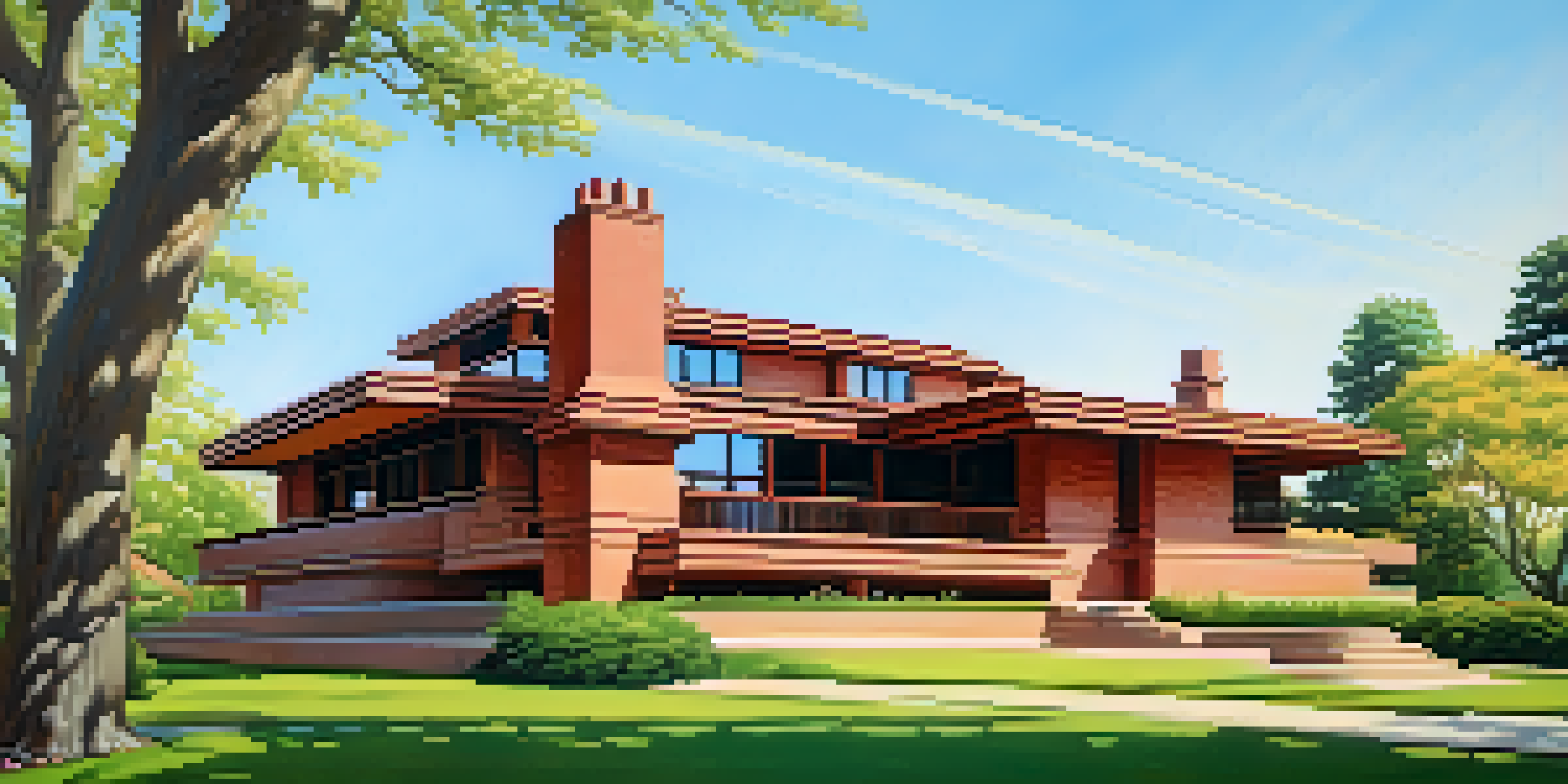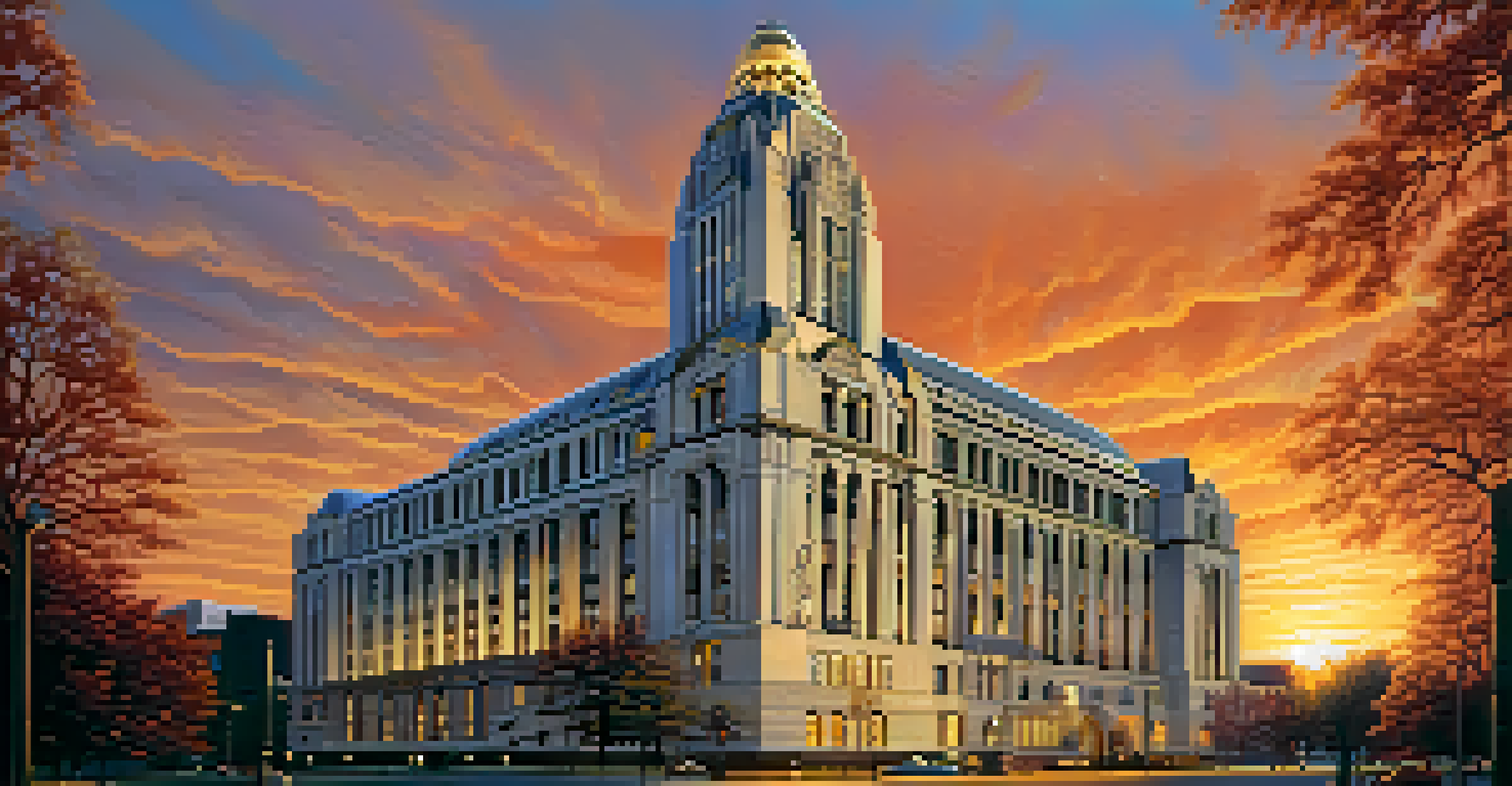Exploring Buffalo's Architectural Gems: A Historical Overview

The Historical Roots of Buffalo's Architecture
Buffalo's architectural story begins in the early 19th century, shaped by its position as a key transportation hub. The construction of the Erie Canal in 1825 propelled the city into a new era of growth and prosperity, attracting architects and builders eager to leave their mark. This influx of talent led to a diverse architectural landscape that reflects various styles and influences, from Neoclassicism to Gothic Revival.
Architecture is the learned game, correct and magnificent, of forms assembled in the light.
As Buffalo flourished, it became a canvas for innovative design. The city's architecture is a testament to the ambitions of its founders and the culture of the time. Notable structures like the New York Central Terminal showcase the grandeur and optimism of the early 20th century, while smaller buildings tell stories of everyday life and craftsmanship.
Today, exploring Buffalo's architectural gems allows us to appreciate not just the buildings themselves, but the historical context in which they were created. These structures serve as a reminder of the city’s rich heritage and the evolution of American architecture.
The Influence of the Prairie School Movement
One of the most significant movements in Buffalo's architectural history is the Prairie School, which emerged in the late 19th century. Led by architects like Frank Lloyd Wright, this movement emphasized harmony between the structure and its surroundings, incorporating organic materials and open floor plans. Buffalo embraced this style, resulting in homes that blended seamlessly with the natural landscape.

The Darwin D. Martin House, designed by Wright himself, stands as a stunning example of Prairie School principles. Its horizontal lines and integration with the garden create a sense of tranquility and connection to nature. Visitors often marvel at how the design enhances the living experience, making it a true architectural masterpiece.
Buffalo's Architectural Diversity
Buffalo's architecture reflects a rich tapestry of styles, from Neoclassicism to Art Deco, showcasing the city's historical evolution.
Exploring these homes offers a glimpse into a more holistic approach to architecture that was revolutionary for its time. It challenges us to rethink how we interact with our environment and appreciate the beauty that can arise from thoughtful design.
The Rise of the Skyscraper in Buffalo
As the 20th century dawned, Buffalo began to embrace the skyscraper, reflecting its rapid industrial growth and urbanization. The city became home to some of the earliest high-rise buildings, showcasing innovative engineering and bold designs. Structures like the Guaranty Building, completed in 1896, are celebrated for their intricate terracotta facades and pioneering construction techniques.
We shape our buildings; thereafter they shape us.
These towering buildings not only changed the city skyline but also symbolized Buffalo's ambition and economic promise. They were designed to capture the spirit of the age, with their heights representing progress and modernity. Today, they stand as reminders of a time when Buffalo was one of the leading cities in the nation.
Visiting these skyscrapers allows us to experience the ingenuity of early 20th-century architecture. Each building tells a story of the visionaries who dared to reach for the sky, leaving an indelible mark on Buffalo’s landscape.
Art Deco: A Glimpse into Buffalo's Glamorous Era
The Art Deco movement brought a touch of glamour and sophistication to Buffalo during the 1920s and 1930s. Characterized by bold geometric shapes, rich colors, and ornate details, this architectural style reflected the optimism of the Jazz Age. Iconic buildings such as the Buffalo City Hall exemplify the grandeur and decorative elements that define this era.
Buffalo City Hall, completed in 1931, is not just a functional space; it’s a work of art. The building's towering presence and intricate detailing showcase the skilled craftsmanship of the time. Its observation deck also offers stunning views of the city, allowing visitors to appreciate the architectural beauty from above.
Importance of Preservation Efforts
Preservation initiatives are crucial for maintaining Buffalo's architectural heritage, ensuring that the city's unique character endures amidst modernization.
Exploring Art Deco structures is like stepping back into a vibrant time of cultural change. The intricate designs and artistic flair invite us to celebrate the creativity that flourished during this period, making it an essential part of Buffalo’s architectural heritage.
Preservation Efforts: Protecting Buffalo's Heritage
As Buffalo's architectural landscape evolved, so did the need for preservation. Many historic buildings faced the threat of demolition as urban development surged. Advocates for preservation emerged, emphasizing the importance of maintaining the city's architectural heritage for future generations to appreciate.
Organizations like the Buffalo Preservation Board work tirelessly to protect significant structures, ensuring that the city retains its unique character amidst modernization. Efforts to restore and repurpose historic buildings breathe new life into them while honoring their past. The revival of the Great Northern Grain Elevator is a prime example of how preservation can lead to innovative uses.
These initiatives remind us that architecture is not just about aesthetics; it’s about storytelling and community identity. By preserving Buffalo's architectural gems, we safeguard the narratives that shaped the city and foster a deeper connection to our shared history.
The Role of Community in Architectural Appreciation
Community plays a vital role in the appreciation and preservation of Buffalo's architectural heritage. Local residents and organizations actively engage in initiatives that celebrate the city's rich history, hosting tours and events that highlight significant structures. This grassroots involvement helps foster a sense of pride and connection to the city’s architectural landscape.
Events like the Buffalo Architecture Foundation’s annual tour encourage people to explore buildings they may have overlooked. These experiences provide a deeper understanding of the architecture and the stories behind them. Participants often leave with a newfound appreciation for the craftsmanship and history woven into the fabric of their community.
Community Engagement in Architecture
Local residents play a vital role in appreciating and preserving Buffalo's architecture through active participation in tours and events.
By engaging with architecture on a personal level, residents become stewards of their city’s heritage. This collective effort not only helps preserve the past but also enriches the community's identity and sense of belonging.
Modern Interpretations of Buffalo's Architectural Styles
As we look to the future, contemporary architects in Buffalo are drawing inspiration from the city’s historical styles while incorporating modern sensibilities. This blend of old and new creates a dynamic architectural landscape that honors tradition while embracing innovation. New buildings often feature design elements reminiscent of Buffalo's historic gems, creating a dialogue between the past and the present.
For example, the Albright-Knox Art Gallery’s recent expansion pays homage to its original structure while introducing modern design features. This thoughtful approach not only enhances the visitor experience but also reinforces the importance of architectural continuity in a rapidly changing urban environment.

Exploring these modern interpretations invites us to consider how history can inform contemporary design. It highlights the ongoing evolution of Buffalo's architectural narrative, reminding us that the past continues to shape the city’s future.